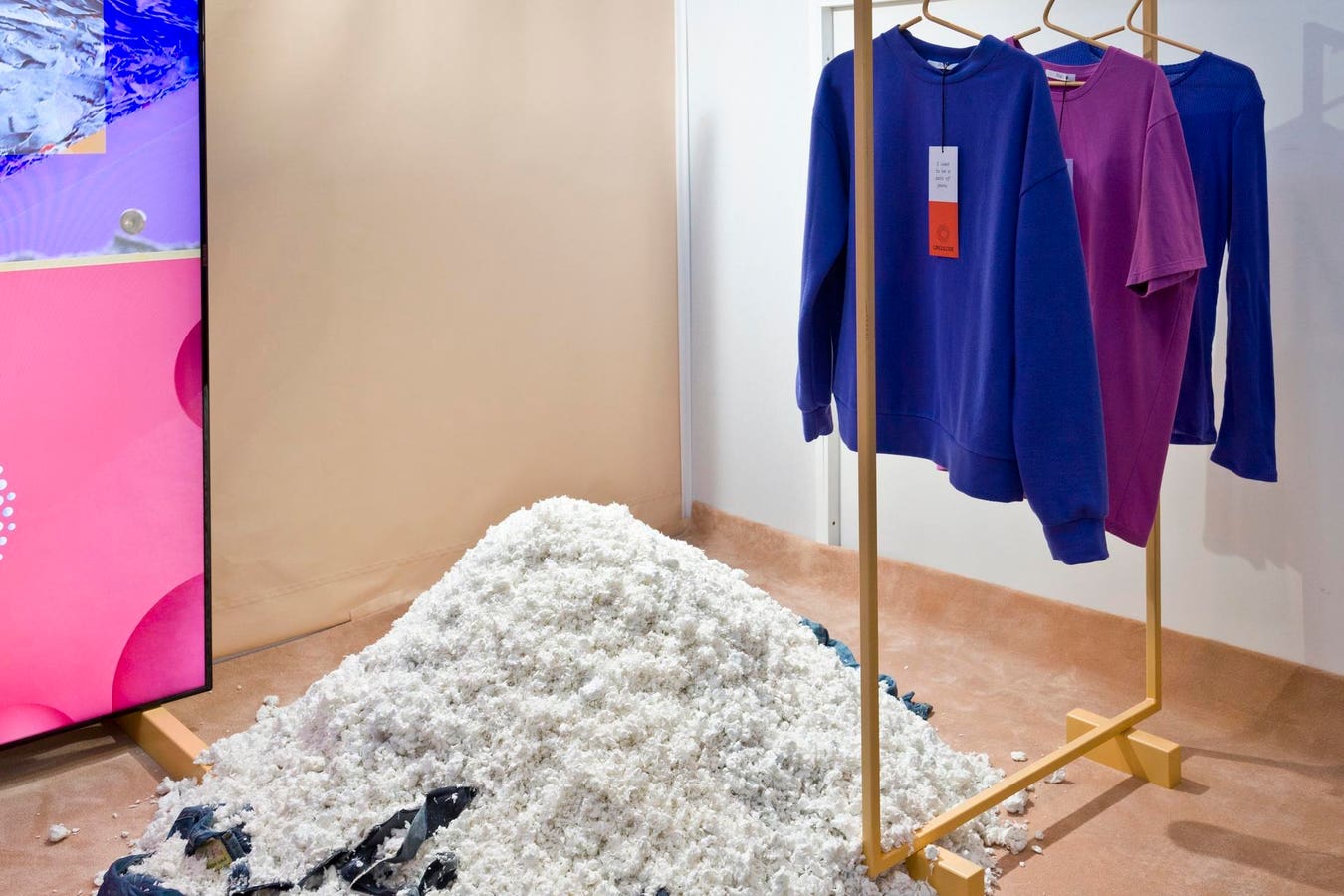Garment’s made from re:newcell’s Circulose pulp, Paris Textile Salons, New York, USA – 16 Sep 2019 … More
After hinting at big news during the recent Challenge the Fabric (CTF) conference, Circulose CEO Jonatan Janmark today announced the textile recycler’s first brand partnership after emerging from bankruptcy in 2024.
“We’re proud to partner with the forward-thinking brand Mango and support their high ambitions in circularity” said Janmark. “Their strong commitment brings us one step closer to restarting the factory and sets a powerful example for the industry. We hope it will inspire other brands to follow their lead.”
Circulose is a regenerated textile ‘pulp’ from 100% waste fabrics, spun into recycled fibres similar to cotton or viscose. The recycler aims to valorise textile waste while decreasing brands’ dependence on higher-impact ‘virgin’ fibres, which face increased European regulation and scarcity due to climate change. With brands, including Mango, setting environmental targets with 2030 and 2050 deadlines, prioritising recycled materials is one way of reducing company emissions, and supply chain risks.
Circulose, formerly Renewcell, closed its factory after going bankrupt in February 2024 then relaunching in November with new investors Altor, Janmark as CEO and ex-H&M Group CEO, Helena Helmersson as chair of the board.
Andrés Fernández, Mango’s Sustainability and Sourcing Director shared Janmark’s pride about today’s announcement: “We’re proud to be the first brand to partner in Circulose’s new phase and look forward to working closely together to advance our shared circularity goal”.
He added: “This collaboration marks a significant step on our sustainability roadmap as we strive to exclusively use fibres with lower environmental impact by 2030.” The roadmap also includes sourcing regenerative cotton to tackle emissions, improve biodiversity and safeguard farmer health and resilience.
Framing the partnership as far from a pilot or one-off ‘collab’, he indicated enduring business integration: “[The partnership] reflects our commitment to fostering a more circular and responsible fashion ecosystem, where innovation and environmental stewardship go hand in hand”.
In an interview conducted as the announcement went public, Helmersson explained that there will be another brand partnership announced soon, despite the tough geopolitical and economic climate. The positive news is reassuring, since Circulose’s business-model of old was viewed a major barrier to scaling its first-of-a-kind chemical recycling technology. Helmersson says her contribution to Circulose’s new chapter lies in her ability to see the proposition from a brand’s vantage point.
“It’s easy for me to have a brand perspective – I know why it’s hard [to implement such initiatives in the face of] unpredictability, with tariffs effecting margins and other challenges”. So how should brand CEOs weigh these partnerships, and integrate them into their businesses?
“When you are the CEO you have a responsibility to make it simple [for your business to implement]
. For example, if you have buyers looking at circular materials that come with the premium, the cost [should be] taken from the top [not solely from their buying budget]”.
Janmark had stated during the CTF conference in May this year that Circulose would be offering a package of ‘value-added services’ to brand partners, including product development support, a fabric library to guide brands in replacing existing fabrics with Circulose ones, and access to a supplier network of fiber spinners and textile mills. The package constitutes a licensing model, including large-scale implementation, such as transition planning, supply chain orchestration, and traceability, according to today’s company statement.
The recycler’s new pricing model was developed in collaboration with non-profits Fashion for Good and Canopy as part of a broader effort to accelerate brand adoption of ‘next-generation’ (low-waste/low-impact novel) materials. Despite their promising credentials, ‘next-gen’ materials have been unable to compete with ‘higher-footprint’ cheaper incumbents, remaining consigned to pilots and small ‘capsule’ collections that have faltered when it comes to industrial scaling.
Helmersson was instrumental in H&M Group’s sustainability investments while COO and then CEO between 2018 and 2024, overseeing direct investments in supply chain decarbonisation that have since placed H&M at the top of NGO Stand.Earth’s annual scorecard of brands phasing out fossil fuels. But as tariffs bite, and decarbonisation of energy remains the sure-fire and measurable action to reduce emissions fastest, why might brands adopt Circulose now, especially when it comes at a premium?
“Mango has a progressive sustainability agenda and their management team sees sustainability as integrated. I think overall, certain companies choose to lead, usually based on 3 things: goodwill..legislation and regulations..and seeing sustainability as an area that will make [the] business more successful”.
While those who act based on goodwill are in the minority, they are the first movers on long-term resilience-enhancing solutions such as new materials, according to Helmersson. She also notes that while brands “must go deep, not broad and shallow” into their supply chains and decarbonise operations, they “should always look at consumer-facing stories too, to connect with [consumer] values and create the relationship to move away from only transactions”.
When it comes to instigating more action from brands on sustainability initiatives, and the three motivators she posits, she has a stark outlook. “The more unpredictable the world becomes, the more [leaders] can [justify] deprioritising goodwill,” she says. “I am a big believer in more regulation in this area – I don’t believe much in goodwill”.
Stand by for my follow-up article where Helmersson reveals the required leadership and conditions for CEO action on sustainability.










